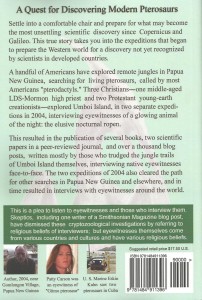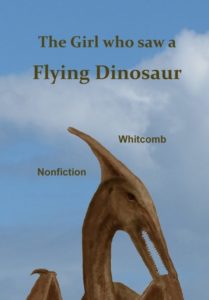The new title for the third edition of my first nonfiction book will be Searching for Ropens and Finding God. This explains cryptozoological investigations of worldwide sightings of apparent modern pterosaurs. Expect many new paragraphs and even new chapters. Here is a sample of what LDS should find strangely familiar, a highly modified portion of Chapter 29 of Second Nephi in the Book of Mormon.
Many of the paleontologists will say, “A live pterosaur?! A live pterosaur?! We have got pterosaur fossils and there cannot be any more live pterosaurs.”
O fools, they shall have pterosaur fossils; and they shall come from among those animals that died during the ancient Flood written of in Genesis. And what thanks do paleontologists give to God for the preservation of basic animal types on the Ark of Noah, written of in the Bible?
Really, for paleontologists who believe in the Bible, what do they mean? Do they remember the labors of those who built the Ark and their diligence to God in bringing forth many basic forms of animal life to all the earth?
O you Bible-believing paleontologists, have you remembered the Ark of Noah, God’s ancient work to save basic animal types? Not the scientists who reject the Bible. They have denounced the Flood of Genesis and hated the scriptures and have not sought to discover live pterosaurs but only fossils. God will hold them accountable, but he remembers those who recognize his hand in preserving life.
Fools shall say, “Pterosaur fossils, we have got pterosaur fossils, and we need no more live pterosaurs.” How did you obtain fossils except from living creatures?
Don’t you know that there have been more pterosaur species than one? Don’t you know that God put all of them on the earth and that he remembers to preserve those that still live on various islands and in other places? God rules in heaven and on earth, and he brings forth various species from the basic life forms that he had preserved on the Ark.
Why murmur or why marvel that, among discoveries of new species, some discoveries should be of basic types assumed long extinct? Don’t you know that the discovery of two or more basic types, such as living Coelacanths and living pterosaurs, is evidence that God preserves basic animal types?
God remembers one basic life form as well as another, preserving Coelacanths and pterosaurs. When people come to know that these two are still living, they will have two testimonies that God is the same yesterday, today, and forever.
Don’t look for the above in the first two editions of Searching for Ropens; it’s not there. The third edition should be published before Thanksgiving . . . I hope. [Update: It was published April 18, 2014, a major revision of this nonfiction book.]
###
Back cover of Searching for Ropens and Finding God
From the title page of this nonfiction book:
This flies high above a common true-life adventure, revealing the early stages of what may become the most unsettling scientific discovery since Copernicus and Galileo. It soars above disputes about religion, revealing why an official discovery of an extraordinary animal was delayed for so long. Above all, this explores human experiences—of eyewitnesses and those who interviewed them. People have become connected by common encounters: Persons of various faiths, with various levels of education, from various countries and cultures, have seen a living pterosaur.
.




